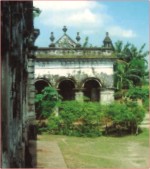| Journey through Bangladesh
From Kurigram
Visiting the Munshibari at Ulipur
Md. Abdul Wahed
 The Munshibari has been standing for 250 years at Ulipur upazila of the district but has understandably suffered a lot of damage. Many of its interesting parts are now so badly damaged you can hardly see them. Among them are the Nat Mondir (play house), Durga temple, Biswanu temple, dining room and kitchen. The Munshibari has been standing for 250 years at Ulipur upazila of the district but has understandably suffered a lot of damage. Many of its interesting parts are now so badly damaged you can hardly see them. Among them are the Nat Mondir (play house), Durga temple, Biswanu temple, dining room and kitchen.
If there was enough concern, it would definitely be possible to preserve this place better. Possible sites for restoration include the Gobinda Mondir, the drawing room, bed room, rest room in the upper floor, bathroom and Shiv temple.
 In the Munshibari, worship is done every day. Local people have been using the pond for their personal uses and other parts of it are being used by the government for a revenue office. Every year Durga Mela is also held within the Munshibari grounds. In the Munshibari, worship is done every day. Local people have been using the pond for their personal uses and other parts of it are being used by the government for a revenue office. Every year Durga Mela is also held within the Munshibari grounds.
Originally, there were 34 acres of land in the name of Bonwari Munshi and Laxmi Narayan. But most of this land has been grabbed. The Islamic Mission and Foundation has taken for itself 7.42 acres of land that had been adjoining the building for 90 years from the Land Ministry, where a hospital and a mosque for the people had been set up. Besides, some land has been given as a yearly lease to local people.
The last servant of the Munshibari, Kanai Lal Sarkar is now an old man. He had been an employee during the period of Brojendra Lal Munshi. He narrated his own version of the history of the Munshibari. During the reign of Nawab Shirajuddaula, Bonwari Munshi had an employee in the drafting department. This is why the Munshi title had been added to his name. During the Nawab's reign, Bonwari Munshi had come for hunting to the area of Dharnibari Union under Ulipur thana with a riverway over the Bamnee. He liked the land and suggested this to the Nawab and requested some for himself. He received 21.20 acres of land for himself and 11.20 acres for Laxmi Narayan. The amount of land around the Munshibari has been going down ever since.
 The servant Kani Lal Sarkar said Bonawari Munshi never had a child. His wife Kadinginee Munshi adopted a son, Binod to serve Laxmi Narayan. But Binod was also childless. So his wife, Krishna Kaminee adopted another son, Brojendra Lal for same purpose. Later Brojendra Lal Munshi's wife, Asharatha Munshi gave birth to two daughters. The elder daughter was Shuchi Rani and younger daughter was Shushaman Kantee who died very young. Shuchi Rani was married off in Kushtia. Later her family had gone on to live in Kolkata. Shuchi in turn adopted a male child for the serving of Laxmi Narayan. The servant Kani Lal Sarkar said Bonawari Munshi never had a child. His wife Kadinginee Munshi adopted a son, Binod to serve Laxmi Narayan. But Binod was also childless. So his wife, Krishna Kaminee adopted another son, Brojendra Lal for same purpose. Later Brojendra Lal Munshi's wife, Asharatha Munshi gave birth to two daughters. The elder daughter was Shuchi Rani and younger daughter was Shushaman Kantee who died very young. Shuchi Rani was married off in Kushtia. Later her family had gone on to live in Kolkata. Shuchi in turn adopted a male child for the serving of Laxmi Narayan.
After the liberation of Bangladesh, Bihari Lal Munshi went to Kolkata. At that time he gave an NGO worker, Saifur Mia, the responsibility of taking care of the Munshi Bari. Then he allegedly handed over the Munshibari to Arif Mia.
 A fight broke out among the locals when Arif Mia tried to stake his claim over the house. In the middle of a heated fight, Arif Mia fired his gun and two local students got shot. One of the students died on the spot, another succumbed to his wounds later. A fight broke out among the locals when Arif Mia tried to stake his claim over the house. In the middle of a heated fight, Arif Mia fired his gun and two local students got shot. One of the students died on the spot, another succumbed to his wounds later.
A case was filed. After dismissing the case, the government took control of the Munshibari and all its property. In 1987, the revenue office of Dharnibari set up in the Munshibari premises, and they still operate there.
Copyright
(R) thedailystar.net 2007 |

